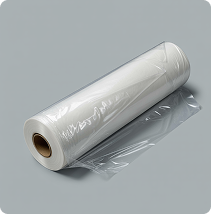How to Replace
Plastic Wrap
Discover reusable alternatives that clean better and never leave you scrambling to the store.

The Problem With Plastic Wrap
🧬Tiny Plastic Particles in Your Food
- 50,000 particles consumed per person yearly: Research suggests people consume an average of 39,000-52,000 microplastic particles each year—with food packaging like plastic wrap being a significant source.
- Heat increases chemical migration: Studies show that microwaving or storing warm food in plastic wrap can cause chemicals to migrate into your meals—something many families do daily without realizing.
- Found throughout the human body: Scientists have now detected microplastics in human blood, organs, and even breast milk—though researchers are still studying what this means for long-term health.
💰Paying More for Poor Performance
- Prices have risen significantly: Like many plastic products, wrap costs have increased substantially since 2020 due to energy and raw material costs—yet the product quality remains the same.
- Limited food preservation abilities: Unlike glass containers or beeswax wraps, plastic wrap often provides inconsistent sealing—meaning food may spoil faster than with better storage methods.
- Constant replacement costs add up: While reusable alternatives like silicone covers last years, families typically go through multiple rolls of plastic wrap monthly—creating ongoing household expenses.
❤️Emerging Plastic Concerns
- Potential cardiovascular risks: A 2024 study found people with microplastics in their arteries had higher rates of heart problems—though scientists stress more research is needed to understand the full implications.
- Possible hormone disruption: Some plastic chemicals may act as endocrine disruptors—particularly concerning for growing children, though effects vary by exposure level.
- Links to inflammation being studied: Emerging research suggests microplastics might contribute to inflammation in the body—an area where scientists are actively investigating connections.
🌍The Legacy We're Creating
- Extraordinarily long environmental persistence: Plastic wrap can take 400+ years to break down—meaning every piece used today will outlast many generations of your family.
- Widespread usage patterns: Millions of Americans use multiple boxes annually—creating habits that normalize single-use consumption for children who learn by watching.
- Significant contribution to ocean pollution: Food packaging materials like plastic wrap account for nearly half of marine plastic pollution—affecting the world we’re leaving for future generations.
This content is for informational purposes only and is not professional advice. Always do your own research before making decisions. No guarantees are made regarding accuracy or outcomes.
Top Picks